Irrigating Michigan blueberries
Irrigated and unirrigated blueberries are showing signs of heat and drought stress.
With all the early rain and irrigation that was used for freeze protection, it seemed that we would never need to irrigate blueberry fields. Unfortunately, we have received almost no rain since the beginning of June. In fact, according to Enviro-weather, we have almost an 8-inch water deficit since June 1, the last day most areas in Van Buren County received any significant rain.
Blueberries grow best in moist soils and perform best when less than half of the availble water has been depleted. Blueberries are shallow-rooted and sensitive to drought stress, and most Michigan plantings are on sandy soils that hold very little water. Severe drought symptoms have been showing up in unirrigated blueberry fields for several weeks as all the availble water in the soil has been used by the plants. Many blueberry growers report that even running their irrigation systems continuously since the beginning of June, they have not been able to keep up with demand. Even planting over high water tables that normally do not need irrigation are beginning to show drought symptoms.
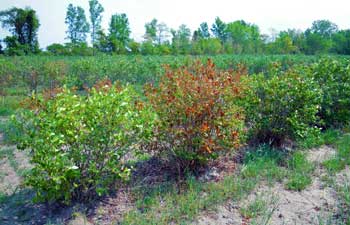
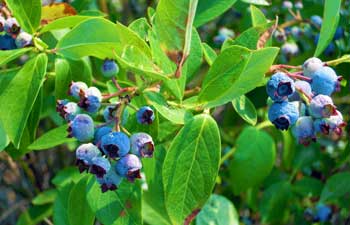
Drought-stressed blueberry bush (left) and close-up of fruit showing the least drought stress (right).
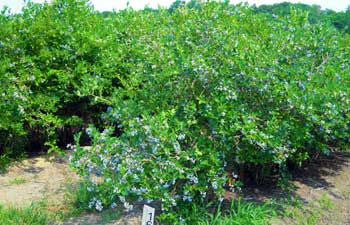
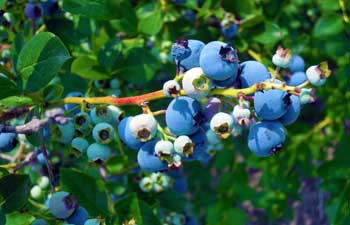
Irrigated blueberry bush (left) and close-up of fruit from irrigated plant (right).
Soil moisture
Soil water reserves depend on soil texture and plant rooting depth (Table 1). You can assume the rooting depth of a blueberry is 12 inches for young plants and 18 to 24 inches for older plants. Sandy soils hold less than 1 inch of available water in the root zone and half of this can be lost in two warm summer days. Loamy sands and sandy loams are common Michigan blueberry soils and hold about 1 to 3 inches in the top 18 inches of the soil. Many blueberry fields have slightly elevated areas that dry out more quickly than other areas. Hardpan or a shallow water table may limit rooting in other areas of fields. This can be seen in older fields where the plants on sandy high spots and wetter low spots are smaller than the rest of the field. These variables complicate irrigation scheduling. As a rule, you should irrigate to maintain the driest most drought-prone areas of your field.
Table 1. Available water in a blueberry root zone as affected by soil texture and rooting depth.
|
Soil texture |
Available water (inches) |
|
In root zone (12-24 inch depth) |
|
|
Sands |
0.4 - 0.8 |
|
Loamy sand |
0.8 - 1.6 |
|
Sandy loam |
1.6 – 3.2 |
|
Loam |
2.0 – 4.0 |
Evapo-transpiration (ET) is the evaporation from the field plus the water lost by the plant (transpiration). Under the hot, dry conditions in June and July, blueberry fields have lost 0.18 to 0.24 inches per day. Daily potential ET values are available on the Enviro-weather website. They are located by clicking the “More weather” link at the top right of the individual station home pages (Photo 1.).
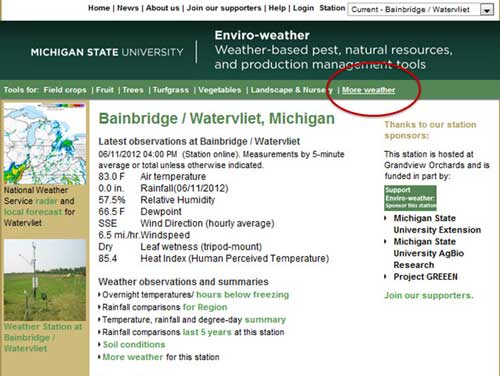
Photo 1. Click the “More weather” link to see daily potential ET values.
The “More weather” page has lots of weather information including irrigation tools at the bottom of the page (Photo 2). Maximum water use during the preharvest fruit growth stage is generally 0.20 to 0.25 inches per day.
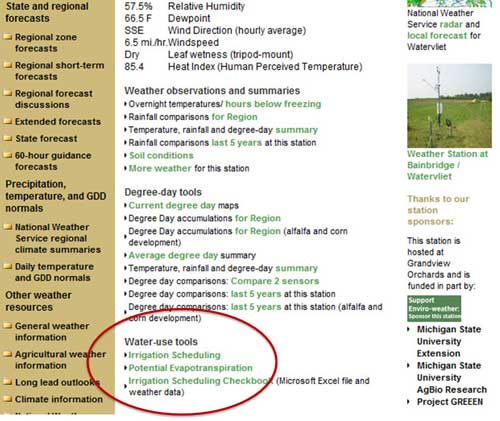
Photo 2. The “More weather” page has lots of weather information,
including irrigation tools.
The evapotranspiration rate varies during the year depending on the amount of leaves on the plant and the heat and relative humidity. By June, when the plants are fully leafed out, the amount of leaves does not change significantly. Many people estimate the vegetation cover of the field to adjust the ET to the actual water loss. A field of mature blueberries with a cover crop will be using water at a rate close to the predicted ET. Younger fields or fields that do not have a cover crop will use less water. Weedy fields will use as much water as well managed fields and the weeds can out-compete the blueberry bushes for soil water because they have large root systems. Temperature is a very important factor; heat increases ET much more than humidity decreases ET.
Irrigation scheduling allows you to replenish the soil water while reducing the amount of water used and loss of nutrients. You need to know how much water the soil can hold. If you know how much water the plants are using, you should irrigate when the plants have used half the available water.
For example, a root zone of 18 inches on a loamy sand soil holds 1.2 inches of available water: If the root zone were depleted by 50 percent, you would need to apply 0.6 inches. This means that irrigation should be applied before 0.6 inches water is lost (three days of 0.20 inches ET) from sands and loamy sands, or 0.8 to 1.5 inches (four to seven days) are lost on sandy loam or loam soils. If the ET for the last several days was 0.25 inches, you would need to irrigate every two days; for 0.2 inches, every three days.
Sprinkler systems
The amount of water applied by solid set sprinkler systems is usually measured in acre inches (acre inch = 27,156 gallons). A system that delivers 0.15 inches water per hour delivers 0.6 inches in four hours. However, about 20 to 30 percent of water from overhead sprinklers may be lost to evaporation, so increase the operating time accordingly. Also, irrigation systems are not completely uniform; they apply more water in some areas than others. The uniformity of sprinkler systems can be measured, but they usually have only 70 (poor uniformity) to 90 percent (excellent uniformity). This means to recharge all areas of the field, even more water than calculated needs to be applied.
In our example, operating time should be increased 20 percent for evaporation losses, plus 30 percent if your system is only 70 percent efficient due to non-uniformity. So, increase the operating time of four hours by 50 percent to six hours to ensure that all areas receive 0.6 inches. With the importance ofGAP inspections and certification, sprinkler systems are of increased concern. Because the irrigation water comes in contact with the fruit, GAP certifiers require tests of the irrigation water. Irrigation water from open ponds or other surface water sources can easily be contaminated with bacteria and if water tests indicate that the bacteria levels are higher than the levels in the grower’s GAP plan, then irrigation should be delayed until after harvest or the problem is remedied.
Trickle irrigation
Trickle irrigation systems can be run daily or on the same schedule as sprinkler irrigation systems. The area wet by a trickle system is much smaller than the entire field wet by sprinkler systems. Since evaporation and uniformity are not significant in trickle systems, we do not need to increase the application time. These systems can be run at one to two hours every day to replace daily plant water use. Ontario, Canada, estimates that peak daily demand of a mature highbush blueberry is about 4.5 gallons per day (18 liters/day).
There are several rules of thumb for trickle irrigation systems.
- For young plants, apply 20 gallons/day per 100 feet of row.
- Mature plantings, apply 35 gallons/day per 100 feet of row.
Here are some useful facts to consider when irrigating blueberries:
- Acre inch = 27,156 gallons, so 0.2 inches = 5,431 gallons.
- Blueberry plants planted in 10-foot rows with 3.5 feet between plants is 1,244 blueberry plants per acre.
- Water use by one of those plants if the ET is 0.2 inches is 4.37 gallons per day.
- If 1 inch shortage of water, then the plant is short 22 gallons water.
- For an 8-inch shortage of water, plant is short 176 gallons water.
It is little wonder blueberry plants are wilting in soils that only hold about a third of the water they need without rain or irrigation.
Additional information:
- MSU Extension's Drought Resources



 Print
Print Email
Email




